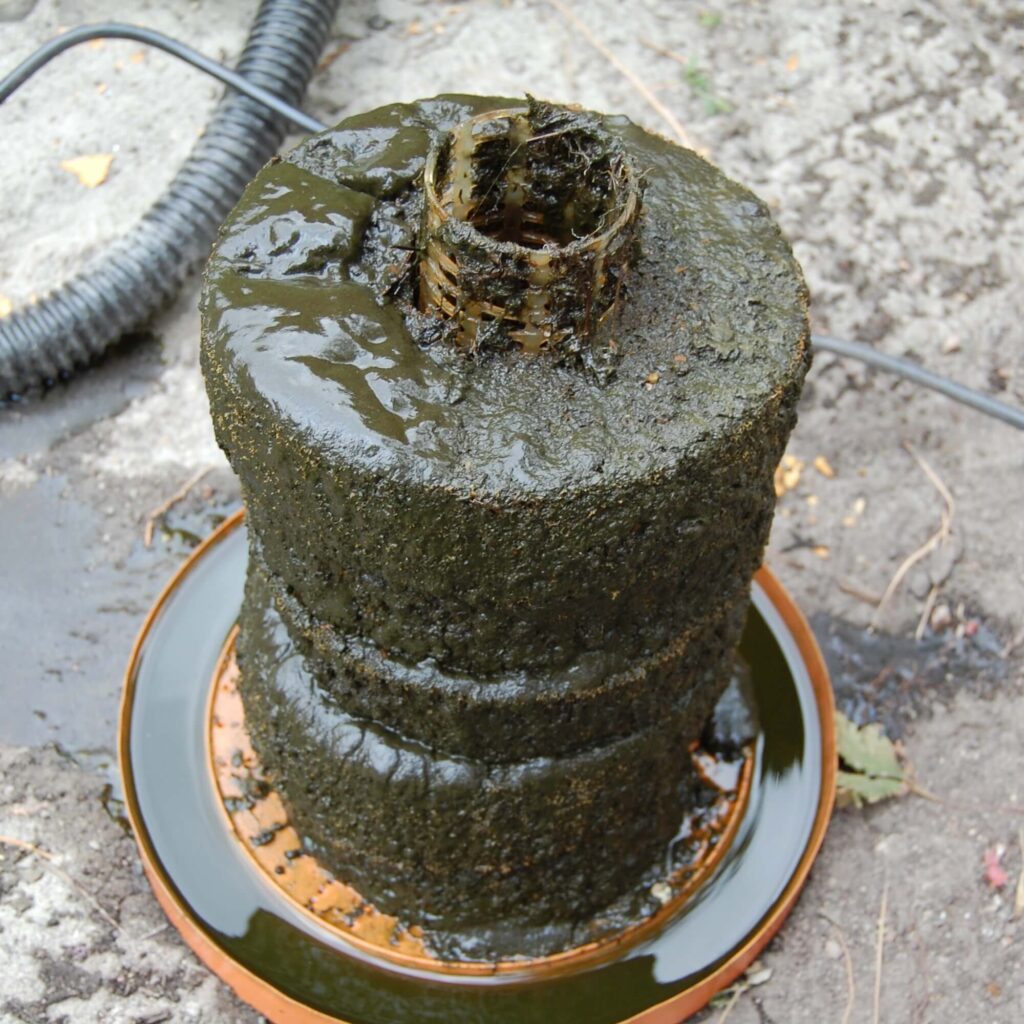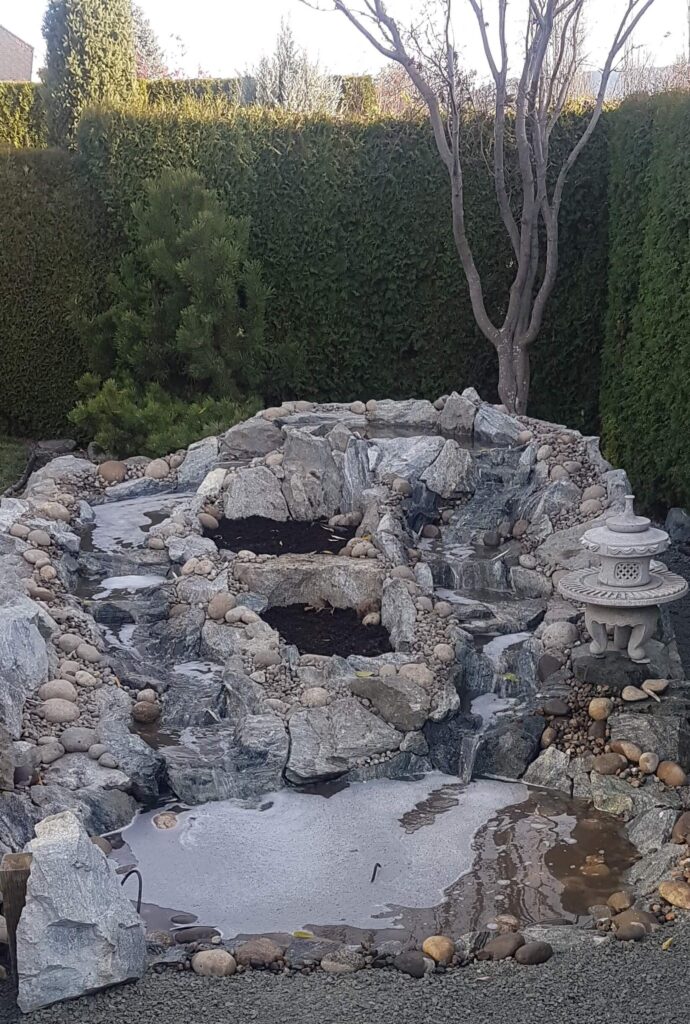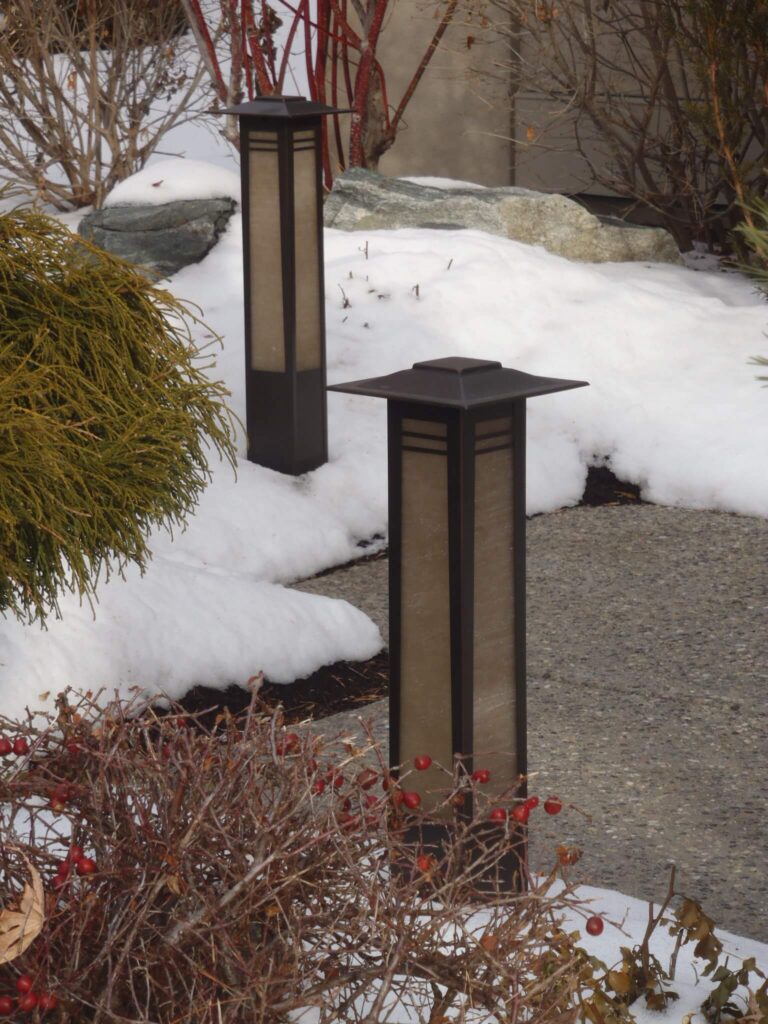We have done thousands of repairs to ponds and water features over the past 18 years. Some of our most common repairs include:

Pumps: We have replaced hundreds of pumps and we definitely have our favorites. A “favorite“ pump for us has several factors; rare to see them on the warranty shelves, are energy efficient, don’t plug up easily, easy to clean, proper sized outlets and impellers that don’t break.
Leak Detection: Leaks can happen pretty much anywhere in a water feature as water takes the path of least resistance. This can occur from low liner, broken hardware, punctured liner, leaking pipes and splash. Hunting for leaks can sometimes be like finding a needle in a haystack, but if you know what you are looking for, you are successful. The only times success in a leak search is limited is when large rocks can’t be moved to investigate or if concrete covers the liner. Even with those restraints, we can usually overcome the issue.
Stream Issues: Personally, I like streams that have to “dance“ a little on the way down to the pond. Water makes the most amazing sounds when it has to work a little. Some people like spring runoff sounds and flow and unfortunately sometimes the builder has to use a much bigger pump than necessary so that they can get enough water going over the feature rocks as most of it is going under the rocks.
Another stream issue we see a lot of is where the stream is just flowing over gravel with no interest and sound. One of my biggest pet peeves is where river rock is used in a stream and no attention has been paid to the shapes of the rocks, they just get dumped in the stream. Mother Nature creates round smooth rocks that the water effortlessly flows over, not jagged, square, broken rocks. It is not practical to sort out the 2 inch and smaller rock, but anything above 2 inch should be looking like they have been in the stream longer than we have been on this earth. We hand pick all of our stream rocks as it looks amazing and the water flows over them effortlessly and that’s how you get the tranquil sounds.
We rebuild streams of every style but our specialty is creating streams with a nice tranquil sound. We seal up all of the feature rocks so that the water flows over the tops and this way we size the pump for the feature to get the right sound for you. Each water effect will have its own sound and without rushing water, you get to hear all of the sounds created by the stream.
Waterfall Issues: We make waterfalls great again. Some problems we deal with are: more water going under the waterfall rock than over, water going off the sides instead of the front, unlevel waterfalls, rockwork falling apart, splash issues and more.

Patching Liner: We have patched hundreds and hundreds of holes in the liner. It can be from pointed rocks under the liner, landscape light stakes pushed through it, bears claws, various other animals compromising the liner, stretched liner and many more causes.
Seaming Liner: We seam liner in most situations. A lot of streams are built with just overlap and the builder does not consider the dam effect, water does back up. We have had to rip apart many streams to eliminate this leak issue. Sometimes the liner has settled too low or has even been cut to low, so a piece of liner needs to be seamed to get the liner high enough again.
Leaking Hoses and Pipes: Depending on the type of pipe used, exposure to sunshine and any low spots in the pipe that freeze, leak issues can happen. The rib style hose tends to develop little geysers over time so we recommend replacement. Usually a new pipe can be run up the side of a stream rather than a large excavation.
Low Liner: usually the liner can be adjusted upwards to get the correct height but if not, a piece of liner can be seamed to the current liner to bring it up to a safe level.
Creating Planting Areas: Pond plants add a lot to a water feature and we carry a good variety from hardy plants to lush tropical and of course the flowering beauties as well.. They do help with the ecosystem but they really look great amongst all of that rock and soften the feature. We can create planting beds or pockets throughout the feature to beautify it with plants.
Cleaning Ponds: Depending on how much organic matter gets into the pond and rots and/or the fish load, the muck can quickly build up and cause an algae problem, or worse yet, the pond can get toxic enough to kill your fish. We do a lot of pond cleaning, which is a big help in getting your pond back in balance. When we clean a pond, we will also recommend changes to help keep the pond easier to keep clean. A lot of ponds have rock in the bottom that needs to be taken out and cleaned every year or two. They say that it is a good thing as good bacteria grow and process those nutrients but good bacteria only grows when the pond is 12 degrees Celsius so only 4 to 5 months a year and that is not enough to process all of those nutrients. We recommend removing the rocks permanently. This will make future cleans easier, faster and cheaper.
Floats: They are great in the fact that you don’t have to top up your pond regularly but they can have issues. They do need to be checked regularly to make sure that they are not running constantly. If they are, they might be set too high and the water is overflowing out of your pond or you have a leak somewhere. It is best to check the float before you get a high water bill. Here in the Okanagan we have a decent amount of evaporation and should lose at least a ¼ to ½ inch of water a day. I say this as not everybody is aware a float is on their pond so if your pond does not go down, look for your float and check it. The biggest trick in the book for people installing water features is to install a float. It hides any water loss issues within the feature until you get your next water bill. Prop a rock under the float so that it does not work and if the pond drops more than a 1/2inch in 24 hours, you probably have a leak issue.
Splash Water Loss Issues: Water falling on rocks can have a huge splash radius that can exit well past the pond liner. We see this a lot and modifications can be made to redirect most of the water back into the liner.
Concrete Issues: Cracking concrete can be an issue, hopefully liner has been installed below it. In most cases we can patch issues and at least reduce water loss substantially.
Pond Lights: Any light underwater goes through a lot of wear and tear compared to above ground lights thus typically having a shorter lifespan. There are very well designed underwater lights that last but they are around $ 300 each.

Landscape Lighting: We can help get your old system working or updated. LED technology has vastly improved landscape lighting and it is definitely worth looking into.
Filter Upgrades: A filter is designed to remove excess nutrients and help keep your water feature a healthy ecosystem. The pump sucks in the nutrients (rotting organic matter and fish poop) and then they get caught up in the filter media, and every week the filter needs to be backwashed. An effective filter backwash should look like chocolate milk when it exits the backwash hose. We have worked with just about every filter system you can imagine and unfortunately most home and store-bought systems are not effective. We have only found one filter that is effective and does what it is supposed to do and is the only one we will install. A great filter has a backwash system that squeezes the sponges and actually gets most of the nutrients out. This is not the industry norm, a lot of filters either scrape the sides of the sponges, use water flow to try and push muck out or worse, no real backwash mechanism. Even the filter we use, we have had to modify it to make it more effective and more user friendly. This filter also has a UV system to help keep your water clear.
It is very important to know that if you get a filter, it has to be backwashed every week or two otherwise the filter gets too full and the muck just goes back into the pond.
Rocks Falling into Pond: Too often, with the way ponds are built, the rocks tend to slide in the pond leaving the liner showing at the pond edge. We use a black foam product to attach the rocks so that they stay in place, perhaps even creating a pond plant area?
Adding Air Systems:
- Summertime: Adding air to the pond has several advantages. Oxygen levels are lower when the water gets warmer so your fish really appreciate the extra air. Air also helps with a pond’s circulation and helps keep the pond healthy.
- Wintertime: Air will help let the gasses escape from a frozen pond and when combined with a pond heater, will give you a second level of safety if you have a failure with one. It is important that the air stones are brought up to 6 to 12 inches below the surface in fall as you don’t want the cold air being pumped down to the bottom where the fish are and the stones are much more effective near the surface
Liner Overlap Issues: Another leak issue we encounter is where two pieces of liner are overlapped to continue a stream or where liners join the pond. If there is not enough elevation between or they are not seamed properly the “dam effect” comes into play and the water level backs up and leaks out where the liners overlap.
